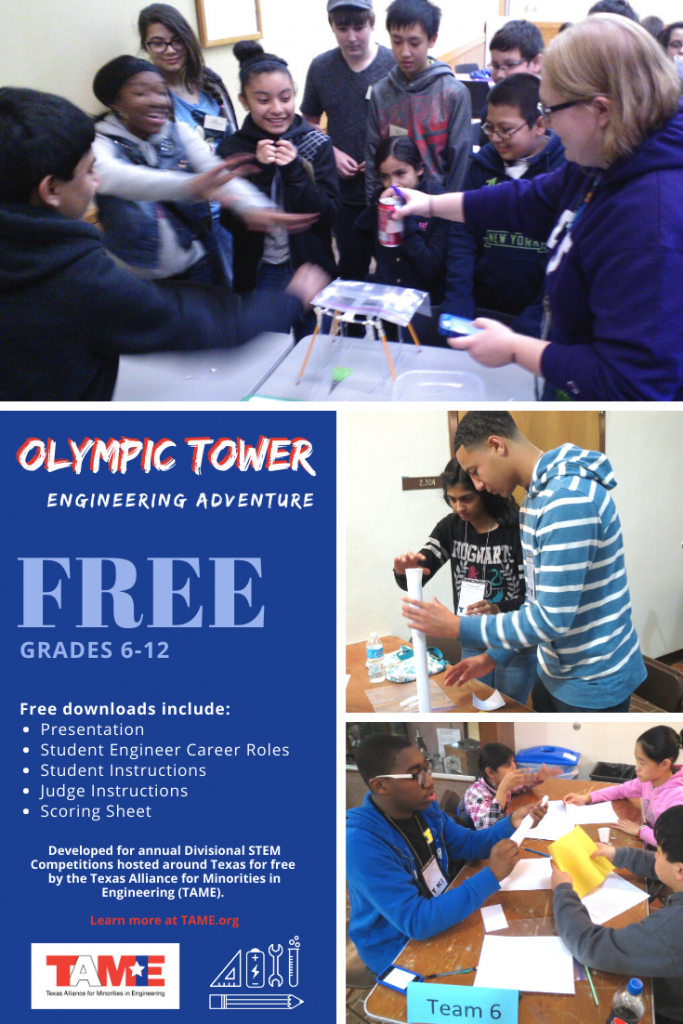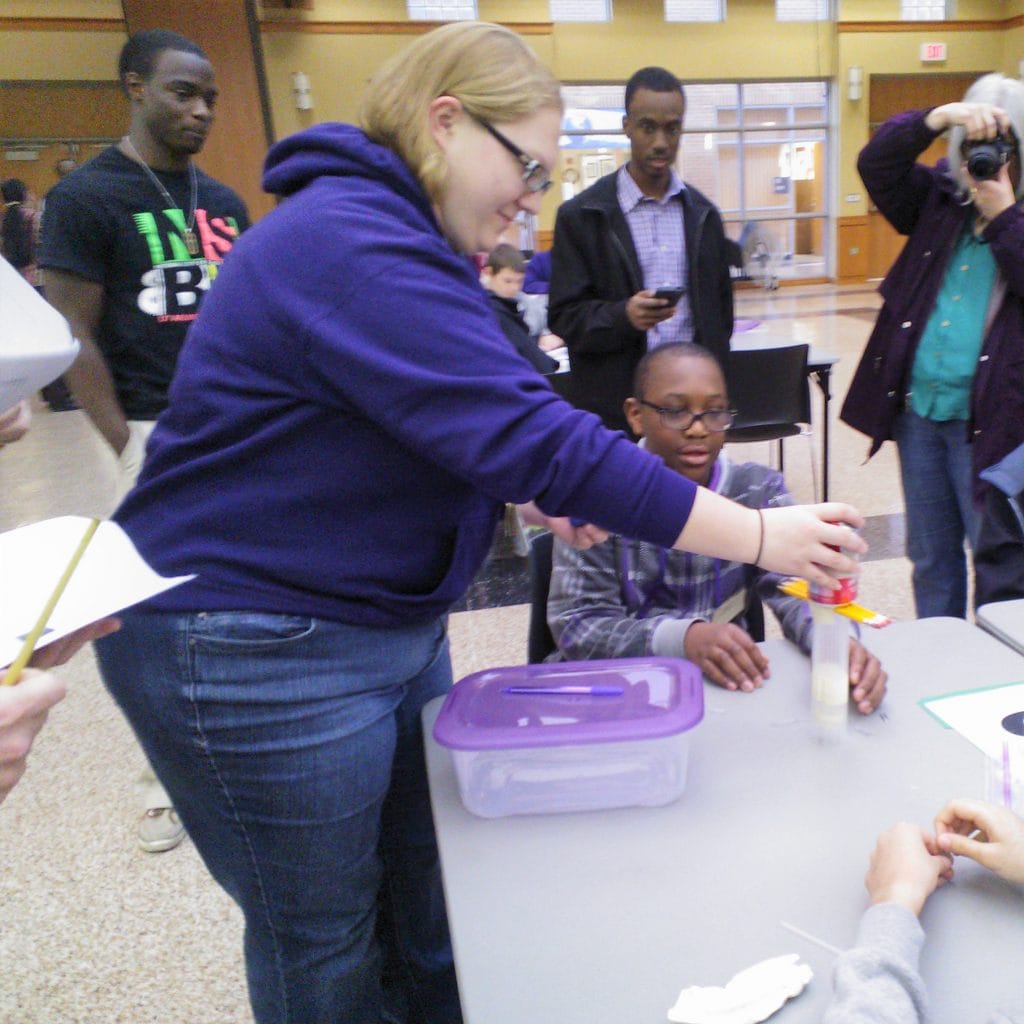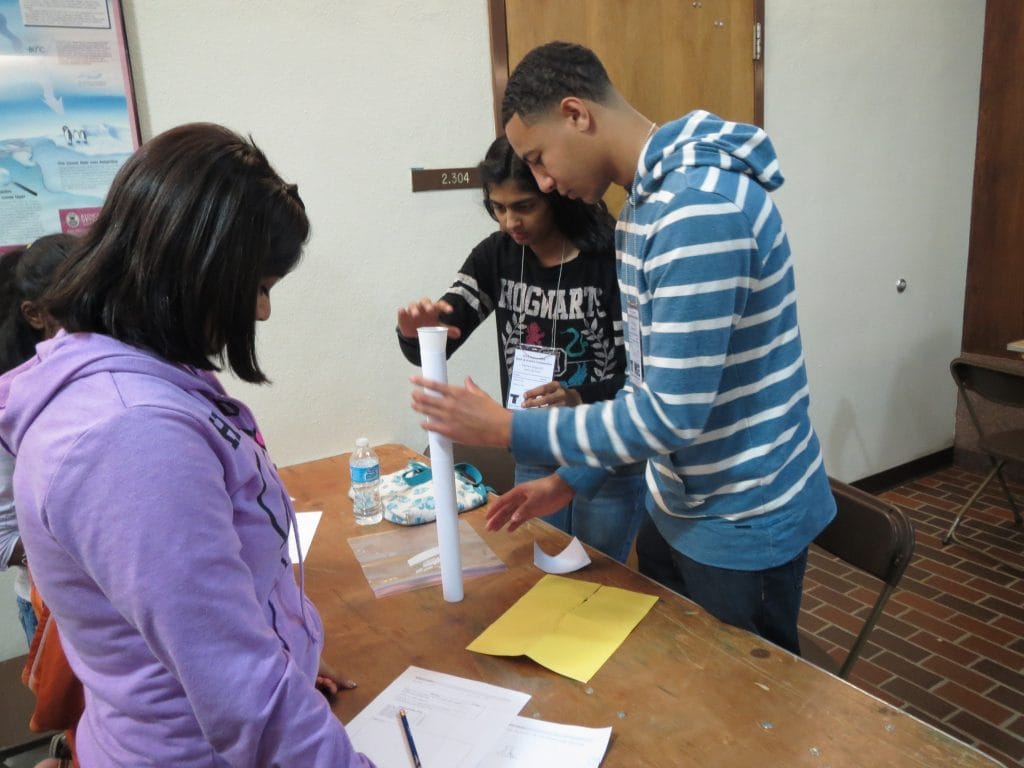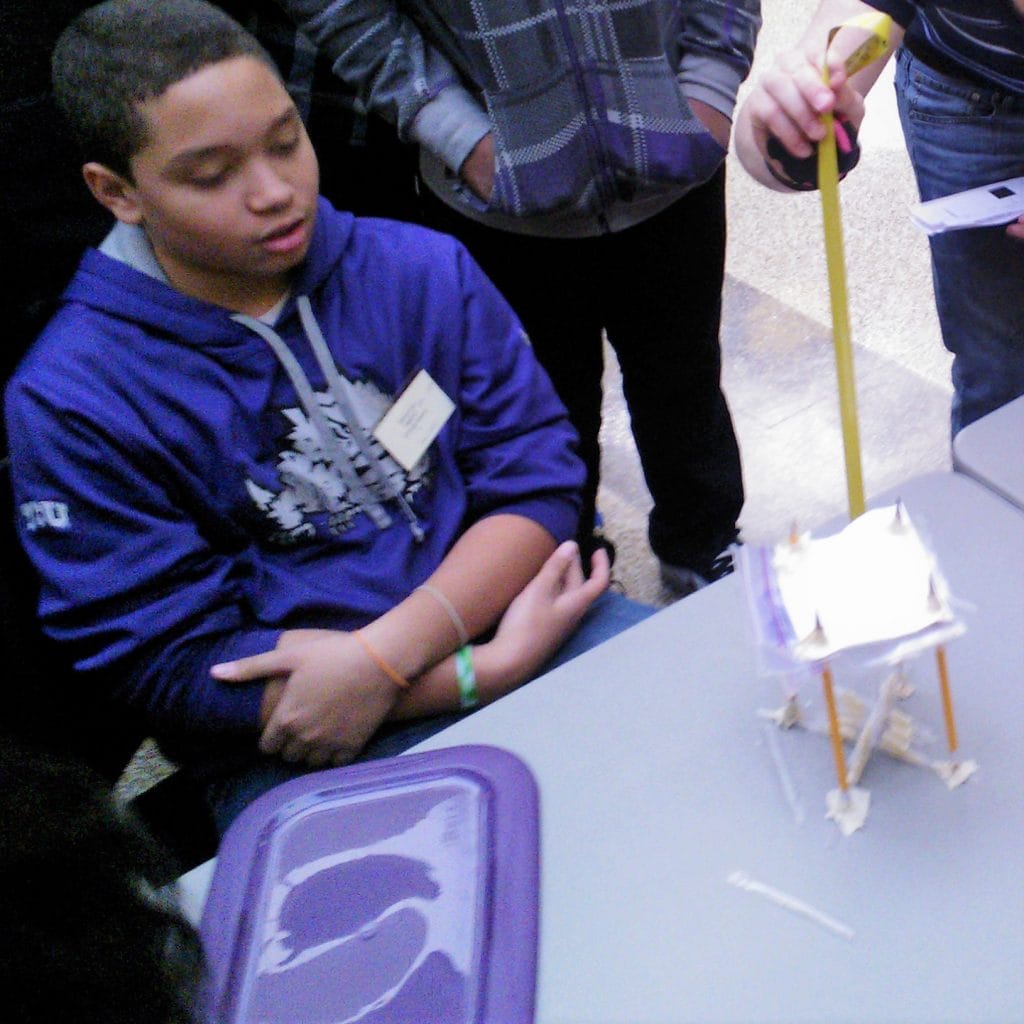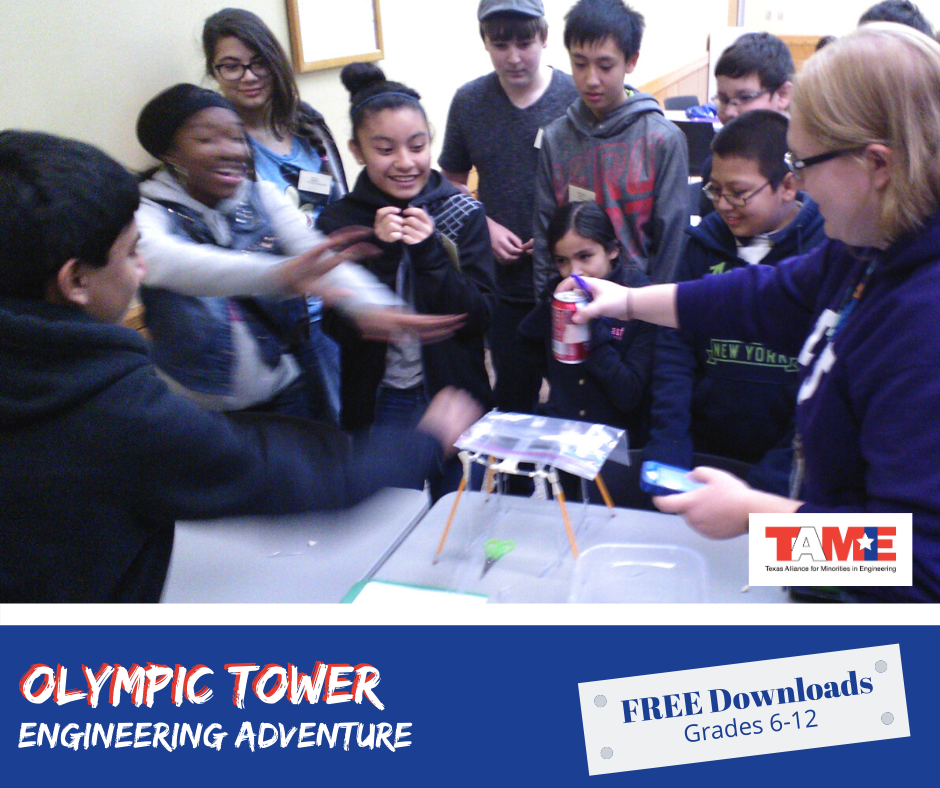
Welcome to TAME Engineering Adventures! Our goal is to help you challenge your students with hands-on learning.
Let TAME kindle your students’ passion for STEM as they take on the 2014 Olympic Tower Divisional Engineering Design Challenge.
It’s a great way to get your TAME Club members to start thinking like engineers in preparation for our STEM Competitions.

Four students of different ages work on a prototype of an Olympic Tower, from the 2014 Capital Area Divisional Math & Science Competition, hosted at The University of Texas at Austin.
Introduction: How to think like an engineer
The emphasis of each Design Challenge is not on winning, but on the collaborative design process. Every challenge is an opportunity for students to practice both individual and collaborative problem-solving and to reflect on how they might improve for the next time.

The Olympic Flame from the 2008 Beijing Paralympic Games. Photo credit to Lindsey Carmichael.
Competition Adventure: Olympic Tower 2014 Divisional Engineering Design Challenge
Help your students get excited about this challenge with a warm-up video about the many creative ways different countries have lit the Olympic Flame, from flaming arrows to elaborate many-petalled feats of engineering. Ask students to pick their favorite and ask what they think it would take to build that design.
Share this Popular Science article about how and why engineers and scientists manage the feat of carrying the flame from Olympia for thousands of miles and across varying landscapes and oceans: The strange history of the Olympic Torch—and why it has to stay lit. For example, did you know the Olympic flame is lit with sunshine and a parabolic mirror, which is curved like a small satellite dish? You can talk chemistry when sharing that the recipe for liquid fuel in the torch, usually some combination of butane, propane, and propylene, can be changed to make it brighter or smoke more to be seen on camera or in stadiums. Learn what went disastrously wrong in the 1956 Melbourne Games when engineers added magnesium and aluminum inside the torch so the flame would sparkle and burn brightly.
“Most importantly, having a pressurized tank of fuel allows for a pilot light hidden inside the top of the torch. This little flame can reignite the whole thing if the main flame goes out, which is crucial given that torch-bearers have to sometimes run in the rain and up mountains where the air gets thin. Engineers have to prepare for all these possibilities.
In an interview with Georgia Tech, Sam Shelton, who created the torch for the 1996 Atlanta games, said that he and his team tested the torch’s endurance by carrying it to the top of Pikes Peak in Colorado, a 14,115 foot summit. He even took the torch into the shower with him to test its ability to withstand rain.”
Stories about this unique challenge are great examples of the engineering design process, which your student teams will use as they build the final Tower at the end of that epic relay race.
Design Brief:
The Olympics are returning! A torch was designed to burn for the duration of the Games. Unfortunately, recent weather destroyed the supporting tower. Your mission today is to build a replacement support using the components salvaged from the original. Your team will design and build a prototype tower that is structurally sound and reaches extravagant heights capable of holding the Olympic flame. You will need to use creative engineering approaches and weigh all trade-offs to solve your challenge.
Using the principles of physics and engineering, you have 45 minutes to design and build a prototype tower to hold the Olympic flame high above the stadium. The tower must be tall enough to be visible outside the stadium walls and strong enough to hold the heavy Olympic torch and the fuel to keep the flame burning for two weeks.
Check out these resources that will guide you through the engineering design challenge, but feel free to make accommodations that best fit your classroom.
Primary objectives: Planning! Focus on keeping your tower stable and reinforced by planning around the variables in your control.
Suggested time:45 minutes
Scoring Summary: The following criteria can be used to score the design of the Olympic Tower.
Total Score = At least 8” tall? + # of weights added + Creativity score + Height bonus
The weights score is calculated based on the number of weights added until the tower is compromised. A tower is compromised when the container falls out of the tower, any weight falls out of the container, or the height of the tower is reduced by an inch.
See below for scoring sheet and additional information.
A volunteer Engineering Design Challenge Judge tests a student prototype at the 2014 Dallas Divisional Math & Science Competition, hosted at Tarrant County College.
Suggested materials
Club Sponsors, feel free to simplify by using materials on hand. In many cases the competitors did not use all the materials, so it is likely you can run this competition with what you have in your classroom.
Materials per team:
RAW MATERIALS, MAY BE ALTERED:
5 sheets of paper
1 sheet of construction paper
2 drinking straws
1 index card
11 inches of masking tape
1 small plastic cup used as the container (may be modified as another container)
OTHER RESOURCES, MAY NOT BE ALTERED OR USED IN PROTOTYPE:
| 1 pair of scissors |
| 2 sharpened pencils |
| Design challenge instructions |
RAW MATERIALS, MAY BE ALTERED:
1 spoon straw
10 drinking straws
10 stirrer straws
1 poster board
1 pair of scissors
Masking tape
1 paper cup
3 metal BBs
1 lump of clay
1 paper lunch bag
OTHER RESOURCES, MAY NOT BE ALTERED OR USED IN PROTOTYPE:
| 1 pair of scissors |
| 2 sharpened pencils |
| Design challenge instructions |
| Small baggie (used for collection) |
| 10 BBs** |
| 1 plastic cup (to measure and pour BBs) |
**In the 2019 engineering challenge that also used BBs, Black Diamond BBs proved to be the best because they are coated to reduce friction. Uncoated BBs are functional but tended to get stuck in the straws more often. TAME tested several brands and settled on Hornady brand Black Diamond Anodized .177 Steel BBs.
JUDGING MATERIALS, MAY NOT BE ALTERED OR USED IN PROTOTYPE:
Plastic tablecloth
Magnetic sweeper (TAME used this brand from Lowe’s.)
Four students of different ages work on a prototype of an Olympic Tower, from the 2014 Capital Area Divisional Math & Science Competition, hosted at The University of Texas at Austin.
Team member roles:
Since one goal of TAME’s competitions is to help students envision a future in a STEM career, all team members are assigned roles, just like a real engineering team. Each person is expected to complete their assigned “deliverable” during the competition. Feedback from participants over the years suggests that this helps students speak up in their role even if they do not know their teammates. Students who use professional titles during the Engineering Design Challenge seem to take more pride in their work and be more likely to identify with a future in STEM.
PROJECT MANAGER
Serves as the team’s primary representative and notifies judges when project is complete and ready for final judging. They are responsible for verifying that all documentation is complete, all requirements are met, and that the project is completed on time.
DESIGN ENGINEER
Leads the design phase for your team. Manages the time restrictions to ensure the team completes each project phase on schedule. Requests judge’s signature when team is ready to have design approved
STRUCTURAL ENGINEER
Leads the team in developing and documenting the optimal design. Completes the Design Drawing and Design Log.
TEST ENGINEER
Serves as the team’s representative during the testing and judging process. The only team member allowed to interact with the tower during judging.
MATERIALS ENGINEER
Ensures that only materials listed in the Material List are used in the project. Leads the building phase of the competition and see that materials are not lost or misplaced.
A student looks on as a volunteer Engineering Design Challenge Judge tests a student prototype at the 2014 Dallas Divisional Math & Science Competition, hosted at Tarrant County College.
Ready to tackle the challenge? Download the materials using the buttons below.
Download the PowerPoint Presentation (PowerPoint file)
Download the Student Team Instructions (PDF)
Download the Judge Instructions (PDF)
Download the Coordinator Instructions (PDF)
A student team looks on as a volunteer Engineering Design Challenge Judge tests a student prototype at the 2014 Dallas Divisional Math & Science Competition, hosted at Tarrant County College.
Post-challenge reflection:
These activities are a great chance for students to observe the joys and frustrations of collaborative design. Once the competition is over, ask your students to reflect on their experience. Was it easy to work with a team? What was easy and what was hard? What would each student do differently the next time? What would they do the same?
Texas Essential Knowledge & Skills (TEKS) for this Adventure
Middle School TEKS Tie-Ins:
Middle School Math
6th Grade Math
- Apply qualitative and quantitative reasoning to solve prediction and comparison of real-world problems involving ratios and rates
- Generate ratios, fractions, and decimals with the measurements of the tower during the construction and design
- Represent data graphically with dot plots, stem-and-leaf plots, histograms, or box plots to evaluate results of the tower’s performance
7th Grade Math
- Solve mathematical and real-world problems involving similar shape and scale drawings of the tower
- Compare data represented in bar graphs, dot plots, and circle graphs and can use to compare different designs of the tower
8th Grade Math
- Create graph and plots to understand the relationships of data gathered about the tower
- Use previous knowledge of surface area to make connections to the formulas and determine solutions for problems involving rectangular prisms, triangular prisms, and cylinders associated with structures of the tower
Middle School Science
7th Grade Science
- Identify advantages and limitations of different designs such as size, scale, properties, and materials
8th Grade Science
- Demonstrate and calculate how unbalanced forces affect the structural integrity of the tower
- Practice appropriate use of resources, including disposal, reuse, and recycling of the material used
High School TEKS Tie-Ins:
High School Math
Algebra
- Consider the associations and causation between the design of the tower and the results of the performance
Geometry
- Have students sketch the top, side and front views and use those views to find the surface area of the the tower
- Have students design and build models with different geometric shapes of the tower
- Help identify two-dimensional shapes of different cross sections of the three-dimensional shapes of the tower
High School Science
Chemistry
- Students can collect data and make measurements with precision and record data using International System (SI) units
- Organize, analyze, evaluate, make inferences, and predict trends from data; and communicate valid conclusions
- Exposure to energy and its forms, including kinetic, potential, chemical, and thermal energies present within the tower’s fuel container system
Physics/Integrated Physics and Chemistry
- Students can collect data and make measurements with precision and record data using International System (SI) units
- Organize, analyze, evaluate, make inferences, and predict trends from data; and communicate valid conclusions
- Students can develop and interpret free-body force diagrams of their tower
Earth & Space Science
- Discuss the optimal locations for the tower and Olympic stadium in different geographical areas, such as near mountains, cliffs, canyons, ocean bluffs, and other landforms in order to apply Earth Science concepts
Looking for more?
TAME offers more in curated idea boards on Pinterest. If you liked these, you’ll love our Engineering: Activities for All Ages board!
With more than 6,000 pins organized into over 50 different boards, TAME’s Pinterest presence is specially curated to help teachers, parents, and students of all ages get excited about STEM.
